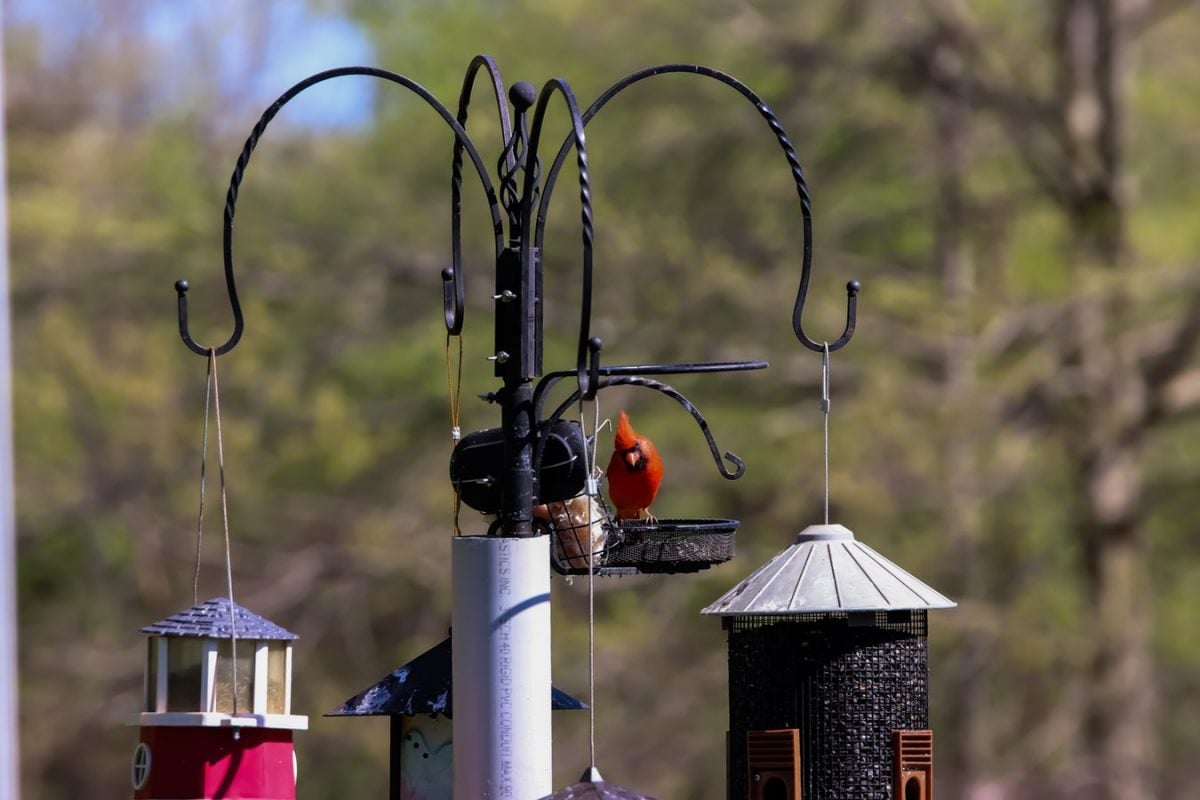As I write this, there’s a male goldfinch pecking at the feeder outside my home office window. A cardinal perches nearby, cracking safflower seeds. And tiny chipping sparrows dart in and out of my cage feeder. Earlier, a red-bellied woodpecker selected a whole peanut and flew off across the yard with its prize.
Watching these birds brings such light and joy to me and my family. My boys have become birding enthusiasts. Ryan, my 10-year-old, diligently checks off what birds we’ve seen in his favorite bird guide. Aaron, now 15, became interested in photography last year due to his love of watching birds flock to our many feeders. He now asks me to take him to walk birding trails on the weekends. These are boys who are generally obsessed with playing video games.
Feed the birds, tuppence a bag,
Tuppence, tuppence, tuppence a bag
“Feed the birds, ” that’s what she cries
While overhead, her birds fill the skies
– From the movie Mary Poppins, song by Sherman & Sherman
I am so grateful to see how this newfound love of watching birds has led to them wanting to go outside more and to a love and appreciation of the natural world. Their delight in seeing a new or rare bird come to our feeder is unparalleled.
When I woke one day recently, Ryan couldn’t wait to tell me about the pileated woodpeckers he saw before we all got up. Aaron sometimes sets his alarm early on the weekends to lie in the chaise lounge by the front bay window and watch the birds flock there.
It’s amazing to me that birds even come to these feeders. It feels like pure grace, especially because when we first started with one lonely feeder hung from a metal shepherd’s crook, no birds immediately came. I thought my boys would quickly grow bored waiting and waiting for something to show up at our little feeder.
We did get a lizard living inside our bird house, which entertained for a little while. Still, no birds. Until one day, there were! A titmouse came to the feeder and quickly darted away. We marveled at it, sneaking outside to see it closer. We laughed at its mechanical bark that seemed to yell at us. We waited by the window every morning to see if one would come back. And it did!
And then cardinals popped by. And the ever-present mourning doves.
Last year, we got to see a whole cycle of life at our feeder. First, the summer birds came: cardinals, mourning doves, titmice, and sometimes flocks of blackbirds and grackles. Due to our study of birds and their food preferences, we now had a variety of bird food and feeders which we changed with the seasons.
As the late fall approached, chipping sparrows clustered on our millet feeder, and goldfinches congregated on the nyjer seed cylinder. We were sometimes graced with the rare bird, a downy woodpecker, a sharp-skinned hawk, a house finch. Chickadees and wrens visited too.
The boys marveled at how at first the goldfinches didn’t look very gold, and female cardinals were dull indeed. And then, the seasons subtly changed, and the birds’ color became more vibrant. We watched as the goldfinches became more and more yellow, until the males were absolutely radiant with color. We watched cardinals feed each other (“They are mating!” my youngest son exclaimed, as he correctly identified the early stage of bird courtship behavior.) We saw birds dance together in midair. And then, a month or two later, juvenile birds appeared at the feeder, with coloring different than their parents.
I learned all of this through my kids’ eyes, and now I reap the benefits as I type this with birds as my companion and continual entertainment.
I learned all of this through my kids’ eyes, and now I reap the benefits as I type this with birds as my companion and continual entertainment. But it didn’t come easy, this birding life. We waited months before any birds came to our feeder. We had to experiment and try new seed and different feeders.
The boys peppered the owner of the local birding store with questions. We bought a bird bath. We changed out the seed every time it became moldy. We cleaned the feeders regularly; well, that was mostly me. But the boys helped install the feeder systems and did much of the bird research for us.
And we waited. And hoped. And kept learning. And now we have a variety of birds at our feeders; birds that change with weather, the time of year, and their stage of life.
It’s so easy for me to get caught up in the world of instant gratification. Birding has taught me the joys of being still. Of watching and waiting. Of getting outside with my kids. Of the rhythms of the seasons. And of the miraculous beauty and grace of the natural world.
So, I encourage you to join me in feeding your neighborhood birds. It’s more than a tuppence a bag nowadays, but the rewards are priceless.
Michele Gregoire Gill is program coordinator of the University of Central Florida’s education doctorate in curriculum and instruction and is a professor of educational psychology in the Department of Learning Sciences and Educational Research. She can be reached at Michele.Gill@ucf.edu.




